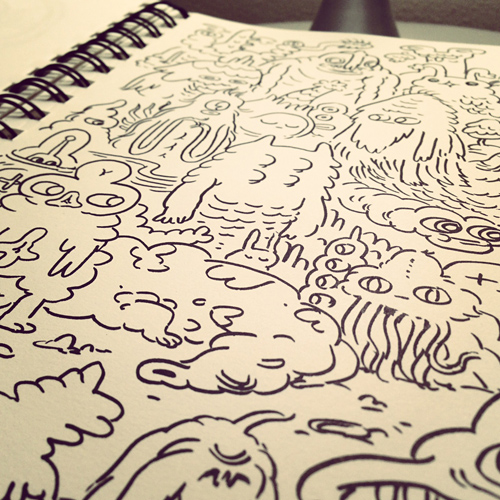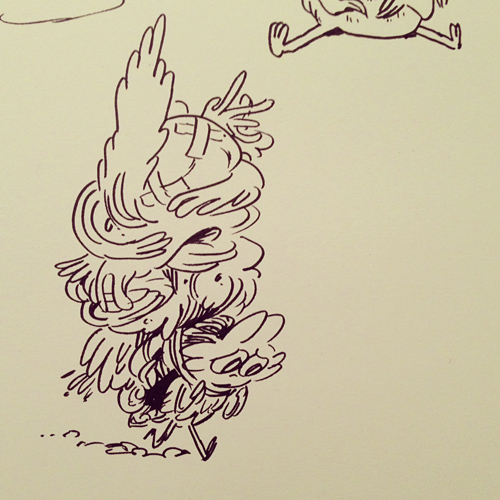photo courtesy Moira Swiatkowski
Last weekend I was at the
Maine Comics Arts Festival (MeCAF), where in recent years my bud and fellow Heeby Jeeby cartoonist,
Dan Moynihan, and I make Free Monster Drawings for anyone who asks. We get a range of teenagers, adults, and kids—people of all ages, really. The two of us take requests and whip up fun little doodles with our shared set of Crayola markers. People seem to like watching us draw, and everyone walks away with a smile. I love it! I always forget to take pictures, but
Dan snapped a few.
I recall one kid who was there with his parents. A budding cartoonist, he wanted to know if we had any advice for someone just starting out. At a show like this, I ask kids if they draw comics, and I tell them how easy it is to fold, staple, and photocopy their own books. I add that they should share what they make online if they can. And I say to simply keep at what they're already doing—keep drawing, A LOT.
But it has occurred to me, a better version of those 'keep drawing' words of wisdom we all tout would be to keep drawing, make A LOT of drawings, and don't worry about making bad drawings.
We all start out that way, and then at some point, someone gives us the idea to slow down and make careful drawings. That same someone introduces us to an astonishing technique: If you draw lightly with a pencil, nice and slow, you can work out all your crazy little details and nuances, and THEN you can ink over it with a pen or marker, adding even more detail! Once you're told that you can and should plan out your drawings, it sticks. Because it works! And you can put that eraser to use in the planning stage, too. Why wouldn't you work this way? It's how the professionals do it, right?

I've been keeping a sketchbook, one that I should really be drawing in more frequently. About a year ago I wrote about how I've been
drawing more with markers—specifically, freehand drawing with markers. By which I mean, I put the pen to the paper and I improvise. I try to shut off that planning part of my brain, and I make it up as I got along. I invent. This is the same thing Dan I do when we make those monsters drawings up in Maine. It should be no surprise, this is what most people refer to as
doodling. But I'd argue that a lot of artists aren't doodling enough. Especially if you spend a lot of time on the computer. If you hit UNDO, you're not doodling. You're not allowing yourself that free flow of blending one mark into another.

Now, I get that doodling is not for everyone. And there are plenty of styles of art and drawing where that planning stage is incredibly important. Roughing in your forms, blocking in your composition, shading, making thumbnails—these are all important steps to creating professional caliber paintings, illustrations, comics...you name it!
Where I think doodling is important has more to do with discovery. Trying things. Messing around. The more you do it, the more familiar you are with how you draw in general. The more spontaneous your ideas will be. It puts you in touch with your imagination. And it frees you up from that pressure of making mistakes. Because who cares if you make a mistake? Work with it! And if you make a bad drawing, there's still plenty more room in your sketchbook to make good drawings.
You don't have to doodle with a pen, brush, or marker, but I do think the permanence of ink switches that planning thing off in your brain. I work in pencil a lot, too—especially when I'm designing characters and roughing in a complicated pose or gesture. You can certainly make quick doodley marks with a pencil that carry a lot of energy. But when I get stuck, I'm now in the habit or breaking out a chunky Crayola marker. I fill up page after page of drawings until something sticks. I like to be able to look back at the mediocre drawings, too. Something that also gets lost with UNDO.
I'll wrap this up by bringing it back to kids...learning how to draw, having fun drawing, but also working at it—getting better at drawing. No matter how good you are, you will make a lot of bad drawings. Oftentimes, you have to pound through a rough patch of bad ones to arrive at that good one.
Draw without that light under-penciling. Forget about planning. Make time for doodling.





































